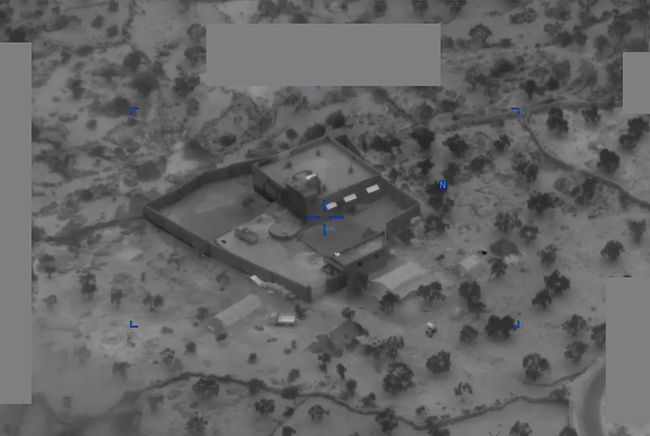
DOD officials on Oct. 30 provided more information about the Oct. 26 raid that led to the death of Islamic State group leader Abu Bakr al-Baghdadi, including this photo of the compound before the raid. DOD photo.
The top US commander in the Middle East on Oct. 30 provided a new look into the Oct. 26 raid that led to the death of Islamic State group leader Abu Bakr al-Baghdadi.
US Central Command boss Marine Gen. Kenneth McKenzie, who oversaw the mission, said the raid in Syria’s Idlib Province targeting Baghdadi was the result of an “intense, interagency effort” to crack down on a priority target.
McKenzie gave the initial go-ahead at about 9 a.m. that day from CENTCOM’s Tampa, Fla., headquarters, and updated the White House on the progress. Eight helicopters loaded with special operations forces staged inside Syria took off on the long-distance flight to the compound. President Donald Trump previously said personnel flew for about 1 hour, 10 minutes to their destination.
The route was carefully planned to avoid IS fighters, and Trump added that the US also contacted Moscow to avoid conflict as they flew over areas with Russian forces.
US remotely piloted aircraft, armed helicopters, and fourth- and fifth-generation fighter aircraft watched over the fight, McKenzie said. As they arrived at the compound, fighters began firing on US aircraft from two posts. CENTCOM showed video of armed military helicopters shooting at a team of fighters. Another group of fighters in a van was also hit.
American forces approached the compound and blew holes in concrete walls. Throughout the operation, six IS members—four women and two men—were killed. They posed a threat by wearing suicide vests and ignoring warnings in Arabic, McKenzie said.
Two other men turned themselves in and were detained. US forces protected 11 children inside the compound from harm, McKenzie said.
Baghdadi grabbed two children, both under the age of 12, and retreated into a tunnel. As a US military working dog closed in and capture was imminent, Baghdadi detonated his suicide vest, killing himself and the two children. Initial reports had said that Baghdadi took three children into the tunnel.
Baghdadi was identified through DNA testing, which directly matched samples taken in 2004 when he was detained at Camp Bucca in Iraq.
US forces, the detainees, and Baghdadi’s remains flew back to the original staging location, McKenzie said. His remains were then buried at sea within 24 hours in accordance with Islamic customs.
The raid lasted about two hours, Trump said. After US forces left, the compound was leveled by multiple airstrikes, including AGM-158 Joint Air-to-Surface Standoff Munitions and precision-guided bombs. McKenzie did not detail the number of bombs, or the aircraft involved, but said the strikes left the compound looking like a “parking lot with large potholes.”
The special operations dog, which since the raid has become an online celebrity, has recovered and returned to duty, McKenzie said. The dog has served on approximately 50 missions in four years with US special operators.
While Baghdadi’s death is a milestone in the counter-terror fight overseas, McKenzie said he is “under no illusions” that the Islamic State’s ideology will subside, even as it looks for a new leader. The IS will likely attempt to hit back, and McKenzie said US forces are “postured and prepared for that.”
“We don’t see a bloodless future,” McKenzie said.